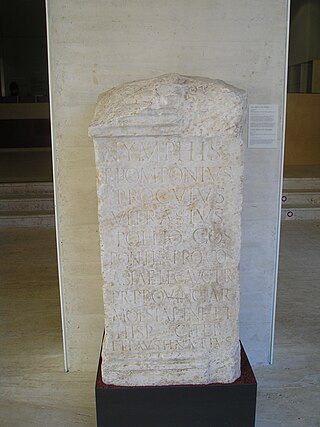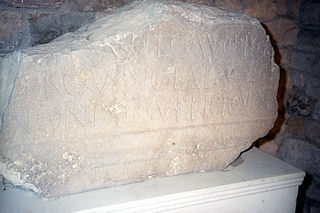Related Research Articles
Gaius Claudius Maximus was a Roman politician, a Stoic philosopher and a teacher of Marcus Aurelius. No works by him are known to exist; however, he is mentioned in a few prestigious works from classical literature.

Titus Pomponius Proculus Vitrasius Pollio was a Roman senator, who held several imperial appointments during the reign of Marcus Aurelius. He was suffect consul in an undetermined nundinium around 151; he was a consul ordinarius in the year 176 with Marcus Flavius Aper as his colleague.
Gaius Curtius Justus was a Roman senator who held several posts in the emperor's service during the Antonine dynasty. He was suffect consul in 150 with Gaius Julius Julianus as his colleague. Justus is known primarily through surviving inscriptions, although he could be identical with the Curtius Justus mentioned as a scriptor rei rusticae by Gargilius Martialis (2.1.4,7).
Lucius Dasumius Tullius Tuscus was a Roman senator who was an amici or trusted advisor of the emperors Antoninus Pius and Marcus Aurelius. He was suffect consul in the nundinium of April to June 152 AD as the colleague of Publius Sufenas.
Titus Prifernius Paetus Rosianus Geminus was a Roman senator of the second century who held a series of posts in the emperor's service. He was suffect consul for the nundinium of May-June AD 146 as the colleague of Publius Mummius Sisenna Rutilianus.
Lucius Annius Fabianus was a Roman senator and general. He was suffect consul for the nundinium of November–December AD 141; his colleague is not known.
Lucius Novius Crispinus Martialis Saturninus was a Roman senator of the second century. He was suffect consul in either 150 or 151 AD. His life is primarily known from inscriptions.
Marcus Pontius Laelianus Larcius Sabinus was a Roman senator and general who held a series of offices in the emperor's service. He was suffect consul for the nundinium of July-August 145 as the colleague of Quintus Mustius Priscus. Laelianus is primarily known through inscriptions.
Titus Flavius Longinus Quintus Marcius Turbo was a Roman senator who held a series of offices in the emperor's service. He was suffect consul for one of the nundinia in the years 149 through 151. Longinus is known primarily from inscriptions.
Quintus Camurius Numisius Junior was a Roman senator active during the later second century AD. He was suffect consul for a nundinium in the first half of the year 161 as the colleague of Marcus Annius Libo.
Quintus Cornelius Quadratus was a Roman senator who held a number of offices in the emperor's service. He served as suffect consul for the nundinium July-September 147 as the colleague of Cupressenus Gallus. Quadratus is best known as the brother of the orator Marcus Cornelius Fronto. He is mentioned four times in the surviving correspondence of the orator.

Marcus Iallius or Jallius Bassus was a Roman senator, general, and literary figure who held several offices in the imperial service during the mid-second century AD. He was suffect consul around the year 159. Bassus is known primarily from inscriptions. His full name was Marcus Iallius Bassus Fabius Valerianus.
Gaius Javolenus Calvinus was a Roman senator of the 2nd century AD who occupied a number of offices in the imperial service, as well as serving as suffect consul between 140 and 143.
Lucius Pullaienus Gargilius Antiquus was a Roman senator, who held a number of offices in the imperial service during the reign of Antoninus Pius. He is known to have been a suffect consul in the early years of the reign of Marcus Aurelius, most likely in the year 162. He is known entirely from inscriptions.
Quintus Voconius Saxa Fidus was a Roman senator, who was active during middle of the second century. He was suffect consul in the nundinium September-October 146 with Gaius Annianus Verus as his colleague. He is known almost entirely from inscriptions; Voconius is mentioned once in Ulpian's Liber octavus de officio proconsulis.

Titus Caesernius Statianus was a Roman senator who held a number of appointments in the Imperial service during the reigns of Hadrian and Antoninus Pius. He was suffect consul in the nundinium of September-October 141; his colleague's name is not known. His full name is Titus Caesernius Statius Quinctius Statianus Memmius Macrinus.
Titus Caesernius Quinctianus was a Roman senator who held a number of appointments in the Imperial service during the reigns of Hadrian and Antoninus Pius. He was suffect consul in an undetermined nundinium around the year 138. His full name was Titus Caesernius Statius Quinctius Macedo Quinctianus.
Quintus Caecilius Marcellus Dentilianus was a Roman senator, who held several imperial appointments during the reign of Antoninus Pius. He was suffect consul in an undetermined nundinium around AD 150. He is known entirely from inscriptions.
Publius Cluvius Maximus Paullinus was a Roman senator, who held a number of imperial appointments during the reigns of Hadrian and Antoninus Pius. He was suffect consul during an undetermined nundinium between 139 and 143. He is known entirely from inscriptions.
Marcus Cominius Secundus was a Roman senator, who was active during the reign of Marcus Aurelius. He was suffect consul in one of the later nundinia of 151 with Lucius Attidius Cornelianus as his colleague. He is known from inscriptions and military diplomas issued during his time.
References
- ↑ Werner Eck and Andreas Pangerl, "Neue Konsulndaten in neuen Diplomen", Zeitschrift für Papyrologie und Epigraphik , 152 (2005), p. 257 (Online)
- ↑ Werner Eck, "Die Fasti consulares der Regierungszeit des Antoninus Pius, eine Bestandsaufnahme seit Géza Alföldys Konsulat und Senatorenstand" in Studia epigraphica in memoriam Géza Alföldy, hg. W. Eck, B. Feher, and P. Kovács (Bonn, 2013), p. 79
- ↑ Géza Alföldy, Konsulat und Senatorenstand unter der Antoninen (Bonn: Rudolf Habelt Verlag, 1977), p. 314
- ↑ CIL VI, 1517
- ↑ Richard Talbert, The Senate of Imperial Rome (Princeton: University Press, 1984), p. 16
- ↑ Alföldy, Konsulat und Senatorenstand, p. 295
- ↑ Alföldy, Konsulat und Senatorenstand, p. 298
- ↑ Alföldy, Konsulat und Senatorenstand, p. 292
- ↑ Alföldy, Konsulat und Senatorenstand, p. 290
- ↑ Alföldy, Konsulat und Senatorenstand, p. 234
- ↑ Alföldy, Konsulat und Senatorenstand, p. 232